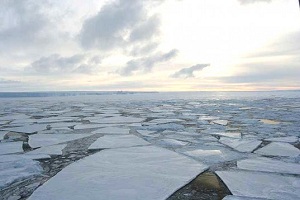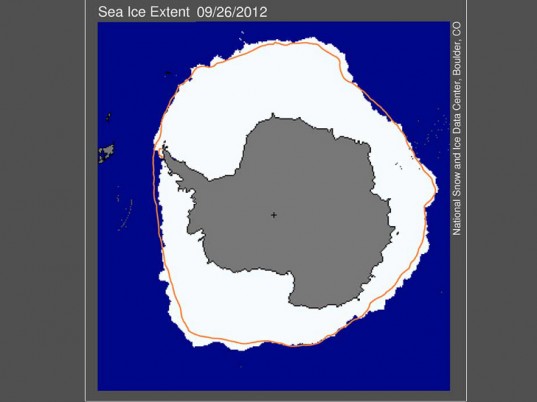Polar Opposites: Why the Loss of Arctic Sea Ice is not Balanced Out by More Ice in the Antarctic
 In September, news media widely reported the record-breaking drop in Arctic sea ice extent. The National Snow & Ice Data Center (NSIDC) reported that the extent of Arctic sea ice reached a record minimum this year on Sept. 16. The extent naturally varies throughout the year and reaches its minimum for the Northern Hemisphere summer in September. The minimum of 3.41 million square kilometers (km) this year was the lowest recorded since satellite measurements began in 1979. However, less widely reported was some news from the other side of the Earth. NSIDC additionally reported that, while Arctic sea ice reached a record minimum, Antarctic sea ice reached a record maximum on Sept. 26 during the Southern Hemisphere winter. But do the record sea ice maximums at the South Pole really balance out the record lows to the north?
In September, news media widely reported the record-breaking drop in Arctic sea ice extent. The National Snow & Ice Data Center (NSIDC) reported that the extent of Arctic sea ice reached a record minimum this year on Sept. 16. The extent naturally varies throughout the year and reaches its minimum for the Northern Hemisphere summer in September. The minimum of 3.41 million square kilometers (km) this year was the lowest recorded since satellite measurements began in 1979. However, less widely reported was some news from the other side of the Earth. NSIDC additionally reported that, while Arctic sea ice reached a record minimum, Antarctic sea ice reached a record maximum on Sept. 26 during the Southern Hemisphere winter. But do the record sea ice maximums at the South Pole really balance out the record lows to the north?
You might think so from listening to critics such as Forbes contributor James Taylor, who complained on Sept. 19 that “none of the mainstream media are covering this important story.” Climate-change critic Christopher Monckton has written that “the global sea-ice record shows virtually no change throughout the past 30 years, because the quite rapid loss of Arctic sea ice since the satellites were watching has been matched by a near-equally rapid gain of Antarctic sea ice.”
Monckton is mistaken, though, according to NSIDC, which reports that
The trend for ice extent growth during Antarctic winters is about 16,000 square kilometers per year (6,200 square miles) or roughly an area the size of Connecticut. In comparison, the decline in Arctic summer sea ice extent is an area about the size of Indiana (91,600 square kilometers per year, or about 35,400 square miles).
Another point to consider is that Antarctic sea ice and Arctic sea ice aren’t necessarily comparable because they are, well, on opposite sides of the Earth. Sea ice is formed under different conditions in the two polar regions. As Natalie Wolchover writes for LiveScience, “The Arctic, an ocean surrounded by land, responds much more directly to changes in air and sea-surface temperatures than Antarctica… The climate of Antarctica, land surrounded by ocean, is governed much more by wind and ocean currents.”
According to some studies, Wolchover writes, climate change has increased westerly winds in the Southern Hemisphere, resulting in more freezing in Antarctic waters in the short term. NSIDC director Mark Serreze tells Wolchover that another factor is the Antarctic ozone hole, which creates conditions resulting in temporarily colder conditions in the Antarctic.
You can return to the main Market News page, or press the Back button on your browser.

